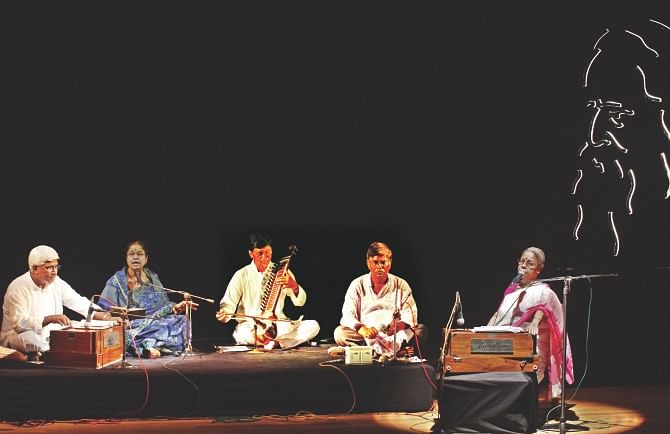… Death is dead, not he; Chhayanaut's homage to the bard
… Death is dead, not he; Chhayanaut's homage to the bard

In his creation “Adonais: An Elegy on the Death of John Keats”, Percy Bysshe Shelley mentioned an excerpt – “He lives, he wakes—'tis Death is dead, not he;” perhaps, we, the Bangalees, feel the same pondering over the physical demise of bards like Tagore and Nazrul. Tagore is omnipresent in our thoughts. Without him and his creations, we have the least to hold on to and take pride in. We find the connotations of life in his literature.
Chhayanaut, one of the leading cultural organisations of the country, observed the 73rd death anniversary of Tagore at its main auditorium on August 8. Dr. Sanjida Khatun, president of the organisation, set off the event with offering a Bhanusingher Padabali number “Moron Rey Tu(n)hu(n) Momo Shyam Saman”. A choral rendition of the song “Shun Lo Shun Lo Balika” from the same poetry followed.
Several noted Tagore artistes performed selective songs at the event. What made every performance evocative was Sanjida Khatun's emceeing of the entire event with excerpts, references, anecdotes, allusions and personal experiences. Tagore enthusiasts soaked in every piece of valued information along with rendition of parts of several songs by Deshikottom Sanjida Khatun.
The Tagore exponent said, “Rabindranath Tagore inserted 'akhor' amid 'kirttan' and thus made each of his composition unique. The style of kothokota (telling old tale/saga with musical tune) takes a prominent place in the bard's compositions. Say for example, in the song 'Krishnakoli Ami Tarei Boli', Tagore tamed the tune of kirttan twice like 'Ghomta Mathaye Chhilo Na Taar Motey” and 'Akash Paan-e Haney Jugal Bhuru' while the entire song followed the style of kothokota. Again, the song 'Tomaye Notun Kore Pabo Bole Harai Khoney Khon' is actually kothokota, but now it is sung following tappa style.” To explain kothokota, the seasoned artiste-researcher also referred to Bibhutibhushan Bandopadhyay's celebrated novel “Poth-er Panchali” where Apu's father Harihar would commence kothokota at the Kashir Ghat.
Abdul Wadul's presentation of the song “Krishnokoli” earned him accolades. His performance “Tumi Nobo Nobo Roop-e esho Pran-e” was fascinating too. Fahmida Khatun rendered two songs “Esho Esho Phirey Esho” and “Aji E Nirala Kunjey” while Azizur Rahman Tuhin's offering of the songs “Jokhon Porbey Na Mor Payer Chinho” and “Ogo Amar Chiro Ochena Porodeshi” was splendid. ATM Jahangir made the audience nostalgic with his superb performance of “Tumi Robey Nirobey” while Tania Mannan mesmerised all with immersing in a baitalik melody “Megh-er Porey Megh Jomechhey”. Saikat Mukherjee and Sifayet Ullah Mukul also rendered solos. And last but not the least; Sanjida Khatun performed the song “Amaye Khomo Hey Khomo” while Warda Rehab danced to the live performance.
Enamul Haque Omar and Swarup Hossain on tabla, Asit Biswas on esraj and Pradip Kumar Roy on mondira accompanied the performances. The event wrapped up with the rendition of the National Anthem.